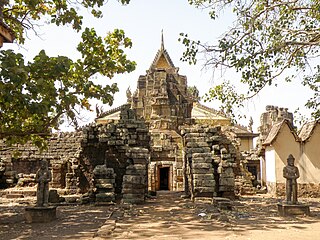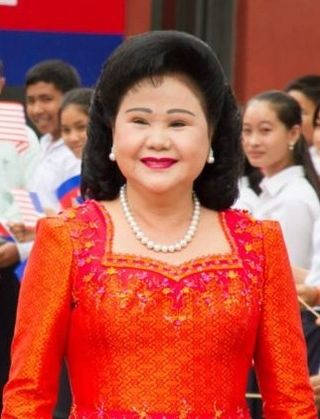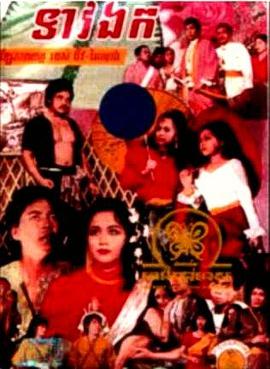Articles related to Cambodia and Cambodian culture include:

Kampong Cham is a province of Cambodia located on the central lowlands of the Mekong River. It borders the provinces of Kampong Chhnang to the west, Kampong Thom and Kratié to the north, Tboung Khmum to the east, and Prey Veng and Kandal to the south. Kampong Cham was officially divided into two provinces on 31 December 2013 in what was seen by many as a political move by the ruling party. All land west of the Mekong remained Kampong Cham while land east of the river became Tbong Khmum province. Prior to this division, Kampong Cham extended eastward to the international border with Vietnam, was the eleventh largest province in Cambodia, and with a population of 1,680,694, was the most populous province in Cambodia. Its capital and largest city is Kampong Cham.

Cambodia is divided into 25 provinces. The capital Phnom Penh is not a province but an "autonomous municipality", equivalent to a province governmentally and administered at the same level as the other 24 provinces.
Throughout Cambodia's long history, religion has been a major source of cultural inspiration. Over nearly two millennia, Cambodians have developed a unique Cambodian culture and belief system from the syncreticism of indigenous animistic beliefs and the Indian religions of Buddhism and Hinduism. Cambodia's achievements in art, architectures, music, and dance from the 9th and 14th century have had a great influence on many neighboring kingdoms, namely Thailand and Laos. The effect of Khmer culture can still be seen today in those countries, as they share many close characteristics with current-day Cambodia. The Tai borrowed from the Khmer many elements of Indianized Khmer culture, including royal ceremonies, customs followed at the court, and especially the Indian epic Ramayana, which influenced not only literature but also classical dance. Even in modern Thai culture the legacy of ancient Khmer culture is still evident.

Islam is the religion of a majority of the Cham and Malay minorities in Cambodia. According to activist Po Dharma, there were 150,000 to 200,000 Muslims in Cambodia as late as 1975, although this may have been an exaggeration. Persecution under the Khmer Rouge eroded their numbers, however, and by the late 1980s they probably had not regained their former strength. In 2009, the Pew Research Center estimated that 1.6% of the population, or 236,000 people were Muslims. In 2021, the State Department estimated the Islamic population at less than 1%. Like other Muslim Cham people, those in Cambodia are Sunni Muslims of the Shafi'i denomination and following the Maturidi doctrine. Po Dharma divides the Muslim Cham in Cambodia into a traditionalist branch and an orthodox branch.
Steung Trang district is a district (srok) located in Kampong Cham province, Cambodia. The district capital is Steung Trang town located around 30 kilometres directly north of the provincial capital of Kampong Cham by road. Steung Trang is a large border district in the north of the province located on the Mekong River. The district lies on the border between Kampong Cham, Kampong Thom, Kratie and Tbong Khmum provinces. It is the birthplace of two Cambodian Prime Ministers: Hang Thun Hak (1972–1973) and Hun Sen (1985–2023).

Tboung Khmum is a district (srok) located in Tboung Khmum province, Cambodia. The district capital is Tboung Khmum town located around 20 kilometres east of the provincial capital of Kampong Cham by road. Tboung Khmum was formerly a central district of Kampong Cham before Tboung Khmum Province was formed from land formerly part of Kampong Cham. The district shares no borders with other provinces and is home to the huge Chup Rubber plantation. The plantation covers much of the land area of the district and contributes a large proportion to the district and provincial economy.

Bun Rany is the spouse of the former prime minister of Cambodia Hun Sen. She also served as the vice president of the National Association of the Cambodian Red Cross and, since 1998, as its president. She has received national and international recognition and numerous awards for her work and endeavor with Cambodia's orphans and poor, HIV/AIDS awareness and prevention, and her emphasis on women's issues with efforts to improve domestic safety and empowerment through education and vocational training. Her full honorary title is Samdech Kittipritbandit Bun Rany Hun Sen.

The Snake King's Child is a 2001 Cambodian-Thai horror film directed by Fai Sam Ang, based on a Cambodian myth about the half-human daughter of a snake god. It was produced as a sequel to the 1970 movie The Snake King's Wife. It is the first full-length feature film for cinema to be produced in Cambodia since before the Khmer Rouge era. The special effect of the lead character's head being full of writhing snakes was achieved by gluing live snakes to a cap worn by the actress.
George Chigas is an American writer, scholar and expert on Cambodian culture and the crimes of the Khmer Rouge. He is currently an associate teaching professor in the World Languages and Cultures department at the University of Massachusetts Lowell.

Tum Teav is a 2003 Romance-tragedy Cambodian film portraying the tragedy of the star-crossed lovers Tum and Teav.

Marriage in Cambodia is a social institution which structures Khmer society. The Khmer wedding, with its long history and rich symbolism, is also famous for its specific music, known as phleng kar.

Cambodian literature, also Khmer literature, has a very ancient origin. Like most Southeast Asian national literatures its traditional corpus has two distinct aspects or levels:
Preah Botumthera Som was a Cambodian writer. He is also known as Venerable Botumthera Som, Brah Padumatthera in French manuscripts, or often simply as Som (សោម). He is considered one of the best writers in the Khmer language.

Teav Aek is a 1972 Khmer film directed by Biv Chai Leang. The film stars Kong Som Eun and Vichara Dany. It is based on the Khmer novel written by Preah Botumthera Som, Tum Teav, which is widely considered the Khmer Romeo and Juliet. This film was remade in 2003 by Fai Som Ang as Tum Teav.

Tboung Khmum, also spelled as Tbong Khmum, is a province of Cambodia located on the central lowlands of the Mekong River. It borders the provinces of Kampong Cham to the west, Kratié to the north, Prey Veng to the south and shares an international border with Vietnam to the east. Its capital and largest city is Suong. The province's name consists of two words in Khmer, tboung and khmum (bee), which together mean "amber or gem".
Alexander Laban Hinton is an anthropologist whose work focuses on genocide, mass violence, extremism, transitional justice, and human rights. He has written extensively on the Cambodian genocide and, in 2016, was an expert witness at the Khmer Rouge Tribunal. He has authored many books, including, most recently, It Can Happen Here: White Power and the Rising Threat of Genocide in the US and Anthropological Witness: Lessons from the Khmer Rouge Tribunal. As of 2024, he is a distinguished professor at Rutgers University.
Pich Tum Krovil was a scholar of Khmer literature as well as one of the most famous performing artists in Cambodia from the late 1960s who helped revive performances after the fall of the Khmer Rouge regime.
Kou Sopheap is a Cambodian Buddhist monk of the Mohanikay sect.











